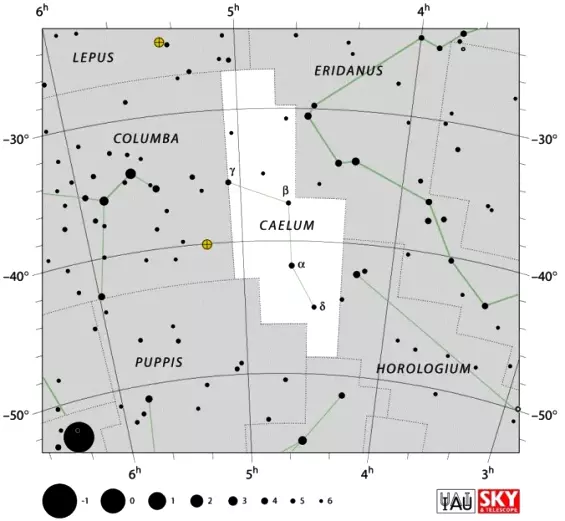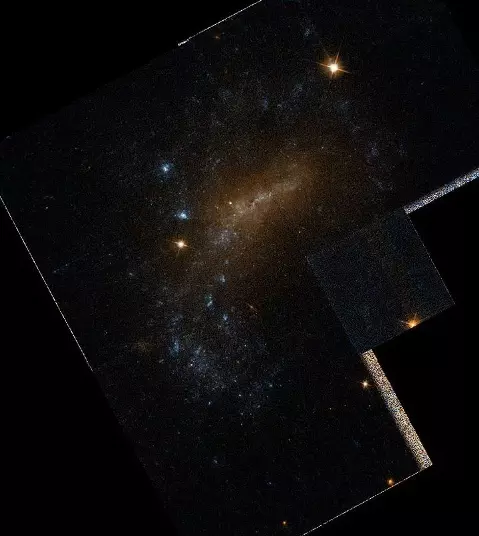Caelum constellation is located in the southern hemisphere. Its name is the Latin word for “the chisel.” The small, faint constellation was originally named Caela Sculptoris, or the sculptor’s chisel. It is one of the 14 constellations created by the French astronomer Nicolas Louis de Lacaille in the 18th century.
Caelum does not contain any prominent deep sky objects and has only two stars brighter than fifth magnitude. The constellation’s brightest star, Alpha Caeli, shines at magnitude 4.44 and is difficult to see from light-polluted areas.
The constellation is home to the faint eclipsing binary star RR Caeli and the unusual quasar HE0450-2958, notable for appearing to lack a host galaxy. Deep sky objects in Caelum include the galaxies NGC 1679, IC 2106 and NGC 1571.
Facts, location and map
Caelum is the eighth smallest constellation in the sky, occupying an area of only 125 square degrees. It lies in the first quadrant of the southern hemisphere (SQ1) and can be seen at latitudes between +40° and -90°.
The neighboring constellations are Columba, Dorado, Eridanus, Horologium, Lepus, and Pictor.
The constellation name Caelum is pronounced /ˈsiːləm/. In English, the constellation is known as the Engraving Tool or the Chisel. The genitive form of Caelum, used in star names, is Caeli (pronunciation: /ˈsiːlaɪ/). The three-letter abbreviation, adopted by the International Astronomical Union (IAU) in 1922, is Cae.
Caelum does not have any stars brighter than magnitude 3.00 or located within 10 parsecs (32.6 light years) of Earth. The brightest star in Caelum is Alpha Caeli. The nearest star, HD 30876, belongs to the spectral class K2V and lies at a distance of 57.86 light years from Earth. Caelum does not contain any named stars. There are no major meteor showers associated with the constellation. Caelum does not contain any Messier objects.
Caelum belongs to the Lacaille family of constellations, along with Antlia, Circinus, Fornax, Horologium, Mensa, Microscopium, Norma, Octans, Pictor, Reticulum, Sculptor, and Telescopium.
Caelum has one star with a confirmed exoplanet, the eclipsing binary RR Caeli. The giant planet in the star system has a mass about four times that of Jupiter and orbits the binary pair with a period of 11.9 years.
Story
There are no myths associated with Caelum. It is one of the constellations introduced by the French astronomer Lacaille in the 18th century. Lacaille named his constellations after various instruments and tools, not stories and myths.
Caelum is depicted as a sculptor’s chisel. It first appeared in Lacaille’s map of the southern stars published in 1756, as “les Burins,” a pair of crossed burins connected by a ribbon. (Burins are sharp engraving tools.) In Johann Bode’s star atlas Uranographia, the constellation still had the longer name, Caela Scalptoris.

Caelum constellation map by IAU and Sky&Telescope magazine
Caelum stars
α Caeli (Alpha Caeli)
Alpha Caeli is the brightest star in the constellation, even if its apparent magnitude is only 4.44. It is a binary star, approximately 65.7 light years distant and about 900 million years old. It is a suspected member of the Ursa Major Moving Group (Collinder 285), a group of stars (including the brightest stars in the constellation Ursa Major) that share similar velocities and likely originated from the same star cluster.
The binary star’s primary component is an F-type main sequence star (Alpha Caeli A) which is a suspected Delta Scuti type variable star; one exhibiting variations in luminosity as a result of both radial and non-radial pulsations on its surface. The star has an apparent magnitude of 4.44.
The companion is a red dwarf belonging to the spectral class M0.5V, with an apparent magnitude of 9.80. It is also a variable star, but of the UV Ceti type (flare star). It occasionally undergoes sudden dramatic increases in luminosity that last for a few minutes.
γ Caeli (Gamma Caeli)
Gamma Caeli is a designation for two star systems separated by 0.22° in the sky. In a small telescope, the system is resolved into a red giant and a white giant with apparent magnitudes of 4.5 and 6.34 respectively.
Gamma-1 Caeli is a binary star that consists of an orange K-type giant, approximately 185 light years distant, and a magnitude eight companion located 3.1 arc seconds away.
Gamma-2 Caeli is also a double star, about 334 light years from Earth. It is composed of a yellow-white F-type giant classified as a Delta Scuti type variable and a companion star of the spectral type F2IV/V, with an apparent magnitude of 9.6.
β Caeli (Beta Caeli)
Beta Caeli is the third brightest star in Caelum, with an apparent magnitude of 5.04. It is a yellow-white F-type main sequence dwarf, located approximately 90.2 light years away. The star’s luminosity is more than six times that of the Sun.
Other notable stars:
δ Caeli (Delta Caeli) is a blue-white B-type subgiant approximately 711 light years distant. It has an apparent magnitude of 5.07.
ν Caeli (Nu Caeli) is a yellow-white F-type main sequence dwarf 171 light years distant. It has a magnitude of 6.06.
Deep sky objects in Caelum
Caelum does not have any prominent deep sky objects, only a few very faint galaxies.
NGC 1679 is a barred spiral galaxy located two degrees south of Zeta Caeli. The galaxy has an apparent magnitude of 13.1 and occupies an area 2.7′ × 2.0′ in size. It was discovered by John Herschel on 18 November, 1835. It lies at an approximate distance of 48 million light years from Earth.

NGC 1679 in Caelum, image based on observations made with the NASA/ESA Hubble Space Telescope, and obtained from the Hubble Legacy Archive, which is a collaboration between the Space Telescope Science Institute (STScI/NASA), the Space Telescope European Coordinating Facility (ST-ECF/ESA) and the Canadian Astronomy Data Centre (CADC/NRC/CSA)
IC 2106 is a barred spiral galaxy that lies approximately 229 million light years from Earth. The galaxy was discovered by Lewis Swift on December 26, 1897. It has a visual magnitude of 13.
NGC 1571 is another galaxy located in the constellation. It has an apparent magnitude of 12.3 and occupies an area 2.0′ x 1.5′ in size.